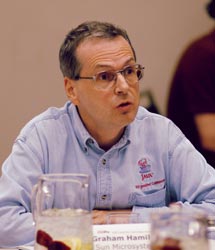|
|||
|
|
|||
Luminaries Debate Issues, Opportunities
JavaOne, June 11, 2003
Technology leaders in the Java vendor community gathered Monday afternoon at the W Hotel in San Francisco to debate and examine, in "town hall" format, the technical issues and market directions for Java technology as they exist now and in the coming year. The Technology Roundtable, under the auspices of Java Pro magazine, focused on three main concerns: software development, Java integration, and open source. Java Pro Editorial Director Dan Ruby introduced the event, and Sun Chief Technology Evangelist Simon Phipps served as moderator. Panel participants represented key segments of the Java-related industry:
Moderator Simon Phipps began by welcoming some new faces at the table and arching his eyebrows in surprise at the one big no-show this year: IBM's apparent boycott of JavaOne. Despite IBM's absence, they were not ignored in the ensuing conversation. The State of Java Development Borland's Ted Shelton said Java's use is declining in the world because of a perception that vendors compete against one another too much. Java grew up without any serious alternatives, but now Microsoft .NET is maturing and will be a "ferocious competitor" to Java. He even heard about companies putting Java projects on hold pending their evaluation of their .NET projects. Ted Farrell at Oracle saw things differently. The 350-plus companies in the Java Community Process that contribute to the Java specification make the platform stronger, unlike the lone company building the .NET spec. "Java will always have this advantage," he said, adding that the Java community is now strong. Graham Hamilton of Sun Microsystems continued that thought by ambitiously stating that he wants to triple the number of Java developers, currently estimated at 3 million. "We tend to rest on our laurels and focus on our current customers," he said. "We need to reach out to new developers and make the tools easier to use." Phipps brought up the fact that according to a recent Evans Data Corporation survey, developers who are migrating now from Visual Basic are moving to Java and C# in roughly equal numbers. This prompted BEA's Benjamin Renaud to note that there's a great opportunity for the Java community to reach people who are abandoning VB. He thought Microsoft blundered when it made VB.NET completely different from VB6. As Microsoft moves to the enterprise, the Java community can "out-innovate them," he said. He's optimistic about this happening because of the Java community's openness and the activity of its corporate participants. Making Java tools easier to use was one of the Roundtable's major themes. Neil McGovern of Sybase said simplifying Java is the key to doubling or tripling the number of developers who adopt the platform. Right now developers leaving VB find Java too hard. "We're confusing the non-elite programmers," he argued. One challenge is integration, which taxes the average IT professional, according to David Chappell of Sonic Software. He said there needs to be an IDE workbench that helps "the everyday IT guy plug apps together," some of them Java, some of them not. In short, we need a "PowerBuilder for Java," he said, alluding to the fact that Roundtable participant David Litwack created PowerBuilder. However, it's damaging if each vendor brings out its own proprietary solution, said Shelton. What we have now is a "market of abstractions."
Renaud echoed Shelton's sentiment: The JCP might be an ugly process, but it's a critical one. To avoid the fragmentation of tools, he said, we need to make the ones out there now more broadly accepted—not to mention target developers who now use Microsoft tools. "So we're in agreement," said Hamilton. "There's one Java language but there's competition on tools and implementations." Novell's Litwack identified three separate camps of activity: J2EE, .NET, and BEA. He said we can't expect a global organization to standardize on one platform. Yet in mobile device development, Motorola's Marc Naddell said vendors can't afford to support multiple platforms and five IDEs. "The mobile community is the poor distant cousin in the Java community." Shelton didn't see any fragmentation in the mobile community. He sees IBM and Borland as the two major vendors in wireless development. He pointed out that Borland is giving demos at JavaOne of Web services operating on cell phones, and said that it's the carriers that are far behind. The Need for Java Integration Hamilton was concerned that APIs are being added too quickly. However, "we've been careful at evolving the language and trying to keep the language simple," he said. Renaud agreed we need stability in the platform. But he said Java now runs applications for the majority of Fortune 500 companies, which says a lot about its power. To him, any notion of Java being long in tooth simply means it's a mature platform. Ed Lycklama of Quest/Sitraka agreed Java is a maturing platform. Vendors are concerned with manageability and serviceability, he said. As new features are added, more complexity is introduced. But Shelton pointed out that manageability and serviceability have nothing to do with Java itself. Chappell thought JSR 208 was a step in the right direction for integration, referring to the new Java Business Integration initiative that extends J2EE with business integration SPIs (Service Provider Interfaces). "What's long in tooth is the desire to keep piling stuff on the same app server stack." Indeed, others agreed that integration was important for Java's continued adoption because, as Renaud put it, Web services are all about integration. They concluded that standardization of integration stacks is therefore a positive development.
And look at the WS-I, Renaud said: Microsoft is giving away protocols but not the APIs. But Shelton cautioned that there's a veneer of interoperability over what are, in fact, proprietary back ends. Chappell noted that Web services by themselves don't solve integration problems. What's needed is an architecture that holds the endpoints together. Keeping the integration server separate is important. Running an integration server on an application server is not always the best choice to make, said Farrell. The Impact of Open Source Because of this thinking, Renaud believes companies would continue to buy mainly from established vendors—such as IBM, Red Hat, and Sun—because they don't want to be sued for adopting something that infringes upon a competitors' proprietary intellectual property. But Shelton countered that the reality is that "people are downloading free things from developers' sites, not from open-source vendors." In fact, he predicted that "software will be free" in five to 10 years. Open-source adoption raises valid concerns, especially regarding quality of support, security, and manageability. Does this imply that open source means revenue from services instead of tools? Litwack said open source is good when its goals are well-defined, not when it's "innovating-as-you-go." Farrell disagreed: Open source is good for all things. However, services aren't scalable, said Renaud, to which Shelton added that no one's built a business around services. "IBM has done it," countered McGovern. The question hangs on which solution solves problems more cheaply: services or software? The jury still seems to be out on that one. According to Litwack, the history of the industry shows that things that once had high value and cost are now nearly ubiquitous and (almost) free. This commodification applies now to the application server market. Chappell added that open source is therefore suitable for things that have become commodified.
Developers like open source, said Farrell, because they like to contribute. Vendors just need to increase developer mindshare. Despite Hamilton's contention that there are "too many Linuxes to support," Renaud said he sees major Wall Street firms running mission-critical applications on open source frameworks. In Litwack's words, this begs the question, "When Linux hits the enterprise—and it will—will it be Java?" He thought yes, not .NET. That means Linux's continued popularity bodes well for Java. Top Issues Facing Java McGovern said the earlier notion of "write once, test everywhere" is a fallacy. "Ease of use" is the new mantra: Indeed, it's critical. Integration technology must be open. The whole nature of integration implies spanning proprietary stacks. We must work hard to keep portal and integration servers open, he said. Litwack said there's too much focus on technology. To paraphrase that famous political slogan, "It's the apps, stupid." IT has reached a crisis of complexity; the old architecture is collapsing and a services-oriented architecture (SOA) is evolving. Learn from Microsoft, he said, which is selling .NET as an SOA. He likened SOA to a second-phase rocket for Java. Hamilton stressed the need to grow the developer base. It's not just a tools problem, but a matter of simplifying the APIs. Java has captured the enterprise market; now it's time for it to move on to other markets. Lycklama wanted to make Java easier to use. "Unix won the server market because it was powerful, not because it was easy to use. Microsoft won the desktop market because it was easy to use, not because it was powerful. We're now at a convergence where we need tools that are powerful and easy to use," he said. Chappell said the Java community needs a new model beyond the application server stack. It needs to focus on standards, and JSR 208 might be key to that end. Shelton warned that the greatest danger to Java is not Microsoft but IBM, which not only has 35 to 55 percent of the application server market, but didn't even bother to come to JavaOne. So the concern is, "Where are they taking the community without us?" IBM is taking the proprietary lead of the server market, he said, and they have a shot at succeeding. "The rest of us could become the poor distant cousins," he said. ATG's Fumi Matsumoto hoped for a Java platform on which applications could live for a long time. Because many J2EE applications are customer-facing, they evolve to meet changing customer needs. "We haven't been focused [enough] on customers, just developers," he said. Farrell agreed with Hamilton that we need to expand the developer base. "Focus on developers with different skill levels," he said. Naddell said it's important to focus on the needs of the purchasing end users. The top four reasons for service adoption are quality of service, reliability of service, support, and ease of use. MIDP 2.0 is a good start, but the UI and controls need to be identical across products and platforms. Renaud said Java is healthier than ever. Community has been its greatest strength and .NET spurs Java's innovation. "Ease of development and ease of integration will deliver value to customers," he said. Finally, Phipps observed that discussing Java automatically means inviting many different vendors to the table. By contrast, discussing .NET means inviting only one vendor to the table—even though, as everyone humorously agreed, there might be as many people sitting at it. "What's encouraging is that there is a discussion," Phipps said. A full transcript of the Java Technology Roundtable will appear in the October issue of Java Pro.
About the Author |



